Overview
Engaging Generation X voters requires effective strategies that understand their unique characteristics, address their economic concerns, and utilize targeted communication methods. Union leaders must prioritize authenticity, practical benefits, and digital engagement to resonate with Gen X. Their voting behavior is significantly influenced by job security and healthcare issues. By focusing on these areas, union leaders can enhance voter turnout and participation.
Furthermore, it is essential to recognize that Generation X values transparency and practical solutions. Incorporating statistics and case studies can help illustrate the impact of union initiatives on their lives. Questions that prompt reflection can also encourage deeper interaction, fostering a connection between the union and its members.
In addition, maintaining a balance of authority and relatability is crucial. While the tone should convey confidence, it is important to acknowledge the challenges faced by union leadership in addressing these concerns. By doing so, union leaders can build trust and credibility with Generation X voters.
To effectively communicate these points, varying sentence lengths will enhance the rhythm of the message. Shorter sentences can emphasize critical points, while longer ones can provide detailed explanations. This approach ensures clarity and straightforwardness in conveying information.
Lastly, utilizing transitional phrases will guide the reader smoothly through the content. Phrases such as ‘Conversely’ and ‘In addition’ will create a cohesive flow, making it easier for union leaders to absorb the key insights necessary for engaging Generation X voters.
Introduction
Understanding the unique characteristics and values of Generation X is essential for union leaders who aim to engage this influential demographic effectively. With a strong sense of independence and skepticism toward authority, Gen X voters prioritize authenticity and practical solutions. This makes them a critical audience in today’s political landscape.
However, as economic pressures mount and frustrations with being overlooked grow, union leaders must consider:
- How can they craft strategies that resonate with this generation’s distinct needs?
The goal is to drive meaningful participation among these voters, ensuring their voices are heard and valued.
Understand Generation X: Characteristics and Values
Generation X, comprising individuals born between 1965 and 1980, is characterized by their resourcefulness, independence, and a strong sense of personal responsibility. This generation commands approximately 29% of the total annual household income in the U.S., underscoring their significant economic influence. Gen X voters place a high value on authenticity and often display skepticism towards authority, which profoundly impacts their voting behavior. They prioritize work-life balance and seek practical solutions over ideological extremes.
For labor leaders, understanding these traits is crucial for effective engagement. Highlighting openness and accountability in union actions resonates with Gen X individuals, who favor clear communication and authentic representation of their concerns. Votem’s innovative online voting solutions enhance accessibility and security, facilitating participation in elections for all eligible voters, including military personnel and individuals with disabilities. As Linda McCulloch remarks, “Implementing Votem’s new, modern system which allowed greater access for all qualified participants from military personnel to individuals with disabilities was my greatest accomplishment in office.”
Furthermore, Votem adeptly managed the receipt of 299,000 votes on behalf of the National Radio Hall of Fame, a notable increase from last year’s 126,000 votes. This exemplifies the effectiveness of contemporary voting solutions in mobilizing this vital electorate. With 54% of Gen X voters expressing frustration that brands consistently overlook them, it is imperative for leaders to actively engage Gen X voters to foster a deeper connection.
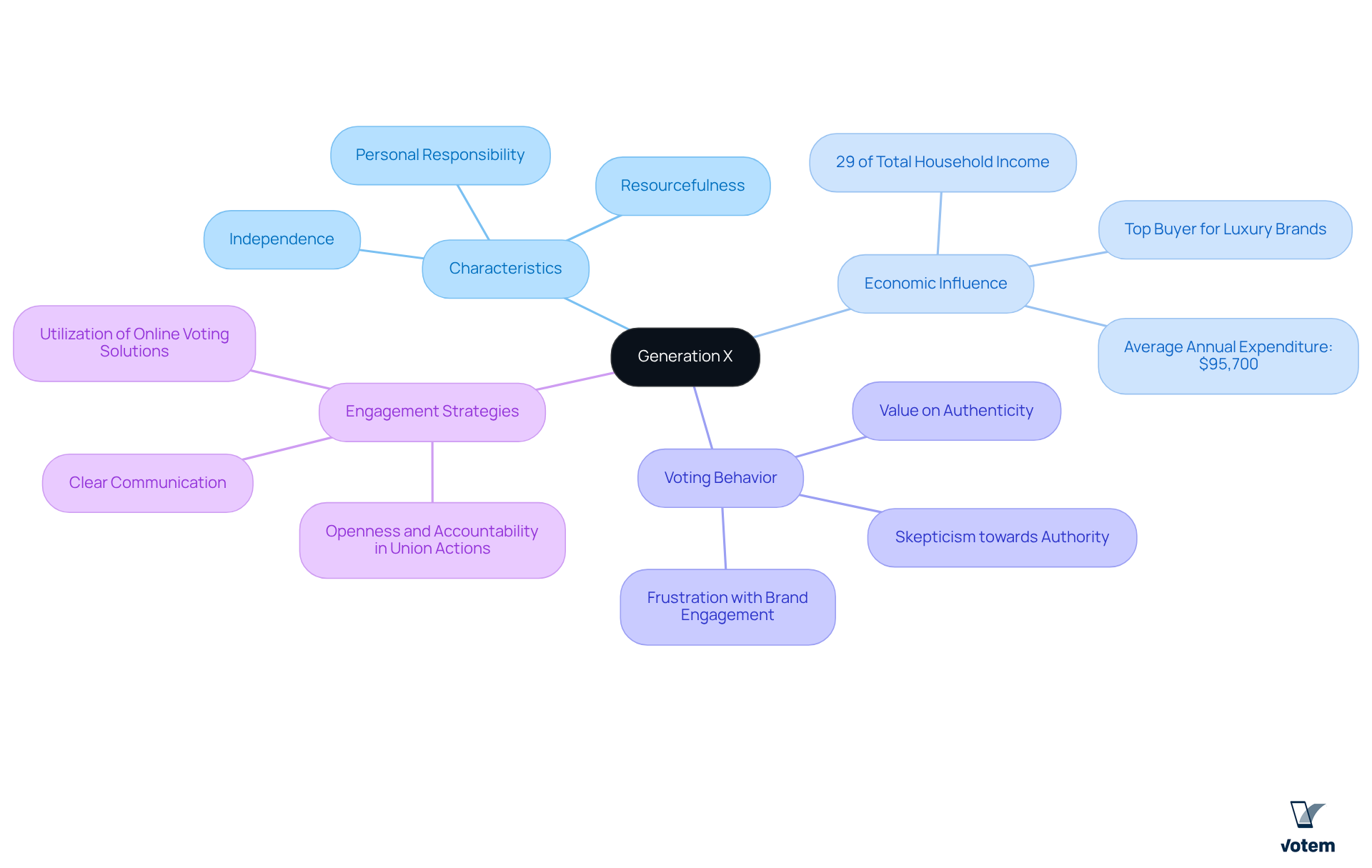
Identify Political Preferences: What Drives Gen X Voting Behavior
Generation X individuals demonstrate a range of political inclinations, often gravitating towards moderate or conservative positions. Central to their voting behavior are economic concerns, particularly job security and healthcare. Their experiences during economic downturns have fostered a pragmatic political outlook, making them acutely aware of policies that directly affect their livelihoods. Notably, in 2023, Gen X boasts a median income surpassing both Boomers and Silents, with 35% earning $150,000 or more, underscoring their economic priorities.
Labor leaders must prioritize these economic issues in their outreach efforts, articulating how collective initiatives can enhance job security and improve working conditions. Successful collective bargaining that results in better wages or benefits resonates strongly with Gen X voters. Recent data reveals that economic pressures significantly shape their political engagement, with many favoring practical solutions over ideological commitments. By aligning collective messaging with these economic realities, leaders can effectively engage Gen X voters and drive higher turnout in elections.
Furthermore, as Chuck Todd noted, understanding the economic landscape is vital for connecting with Gen X voters, who consistently seek tangible benefits from their political choices. This demographic’s focus on economic stability presents a unique opportunity for union leadership to craft messages that resonate deeply, fostering a sense of urgency and relevance in their outreach.
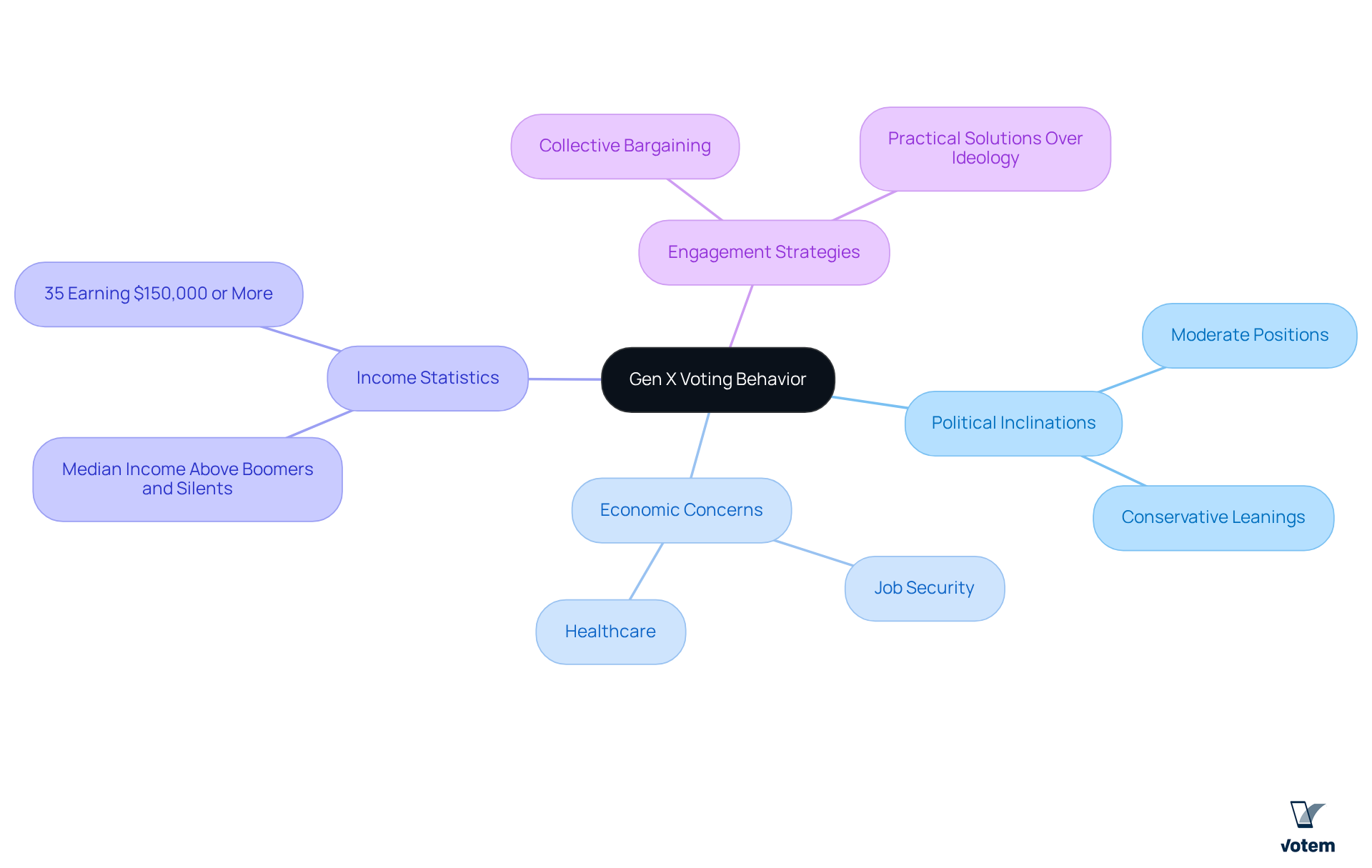
Implement Engagement Strategies: Best Practices for Union Leaders
To effectively engage Generation X voters, union leaders should adopt the following best practices:
-
Leverage Digital Communication: Union leaders must utilize social media platforms like Facebook and Instagram, where 78% of Gen Xers maintain profiles, alongside targeted email campaigns. Messages should be concise and informative, addressing key issues such as economic stability and job security that resonate with this demographic. Particularly, concerns about rising grocery prices and housing costs should be highlighted to capture their attention.
-
Foster Community Engagement: Organizing events that promote face-to-face interactions, such as town hall meetings, workshops, or informal gatherings, is essential. These initiatives foster trust and encourage open discussion about organizational efforts, enhancing loyalty and participation. Furthermore, highlighting success stories from labor organization participants during these events can effectively illustrate the positive impact of belonging to such groups.
-
Highlight Practical Benefits: It is crucial to clearly communicate the tangible benefits of union membership, including improved wages, job security, and access to healthcare. Practical examples, such as testimonials from satisfied participants, can effectively demonstrate these benefits and draw attention to the value of union membership.
-
Encourage Feedback: Establishing channels for participants to express their opinions and concerns empowers Gen X voters and enables leaders to adjust strategies based on their feedback. This fosters a sense of ownership and involvement among members. Implementing robust feedback mechanisms ensures that member voices are heard and valued, reinforcing their connection to the union.
-
Utilize Data-Driven Insights: Analyzing voting patterns and preferences of Gen X voters is vital for continuously refining engagement strategies. By utilizing data analytics, labor organizations can customize their outreach efforts to address the needs of modern workers, ensuring that initiatives remain pertinent and efficient. Ultimately, this approach boosts electoral participation and enhances the organization’s influence.
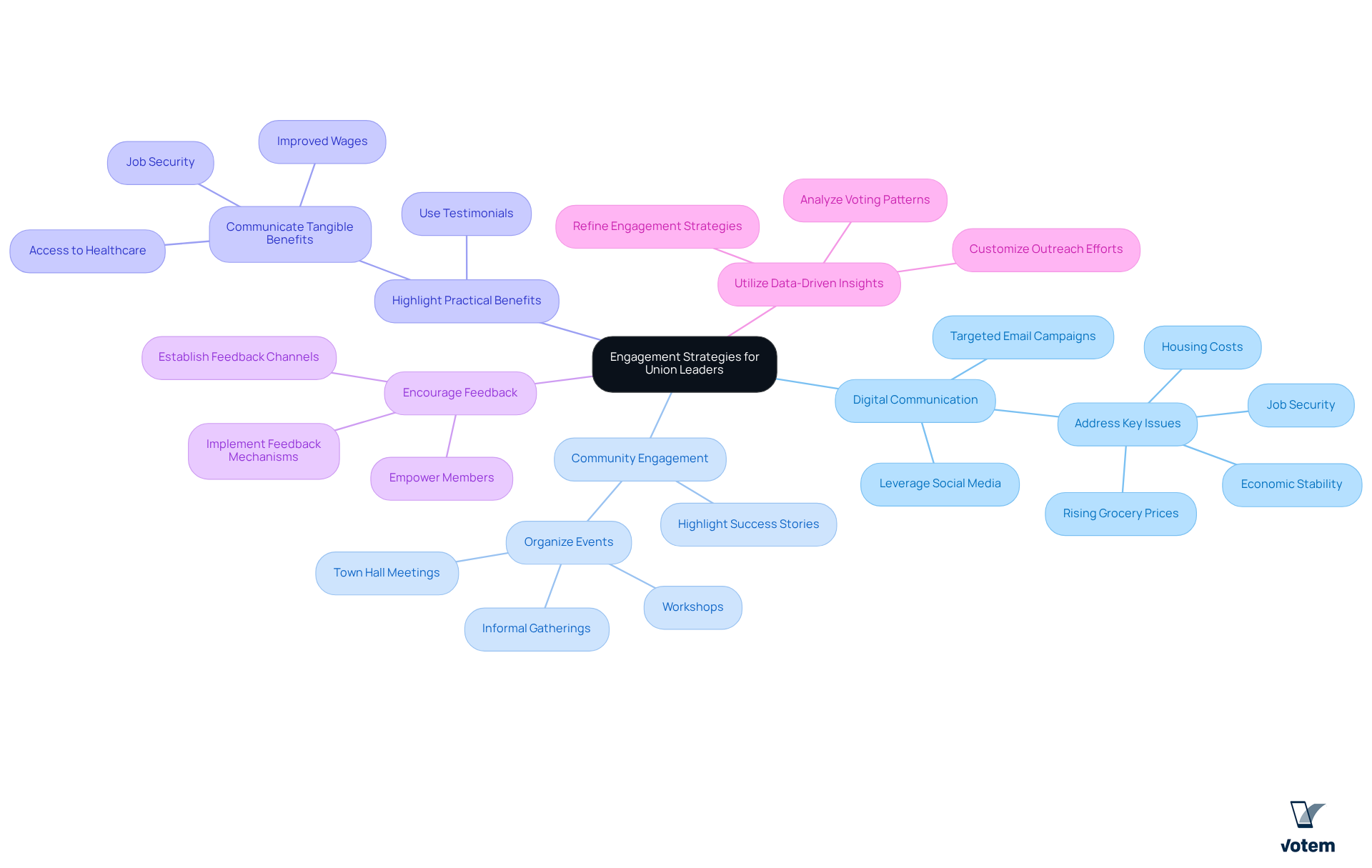
Measure Engagement Success: Evaluating Strategies and Outcomes
To effectively evaluate engagement strategies with Gen X voters, union leaders must concentrate on several key metrics that can drive impactful outreach efforts.
-
Voter Turnout Rates: Monitoring participation in union elections and events is crucial for assessing the effectiveness of outreach. In recent years, registration rates among younger generations have lagged behind those of older groups, underscoring the necessity for targeted strategies to enhance turnout. Notably, Gen X voters, comprising 46 million individuals in the U.S., are vital to the workforce due to their experience, making their engagement essential.
-
Member Feedback: Implementing regular surveys provides valuable insights into member satisfaction and identifies areas for improvement. This feedback is critical for refining engagement strategies, ensuring they resonate with Gen X voters, who often seek meaningful participation in collective activities. For instance, understanding that 40% of Gen X voters have saved nothing for retirement can inform tailored engagement strategies that address their financial concerns.
-
Social Media Engagement: Analyzing interactions on social media platforms helps gauge the effectiveness of messaging. Understanding which topics generate the most interest can guide future communication approaches, especially as younger individuals increasingly turn to digital platforms for information. Leveraging Gen X’s pragmatism and adaptability, alongside Millennials’ innovative ideas, can enhance these strategies significantly.
-
Event Attendance: Assessing participation in collective gatherings enables leaders to discern which formats and subjects resonate most with Gen X voters. This demographic values flexibility and relevance; thus, tailoring events to their preferences can enhance participation. Case studies, such as the “Challenges of Gen X Engagement,” illustrate the importance of addressing their unique needs.
-
Retention Rates: Evaluating membership retention is essential for understanding how effectively the organization addresses the needs and expectations of Generation X constituents. High retention rates often indicate successful engagement and satisfaction, especially among Gen X voters, reflecting the organization’s ability to tackle the unique challenges faced by this generation. Expert insights suggest that collaboration between generations is key to fostering a supportive environment.
By concentrating on these metrics and incorporating pertinent statistics, expert perspectives, and case studies, union leaders can develop a clearer understanding of their engagement success and make informed decisions to boost participation among Gen X voters.
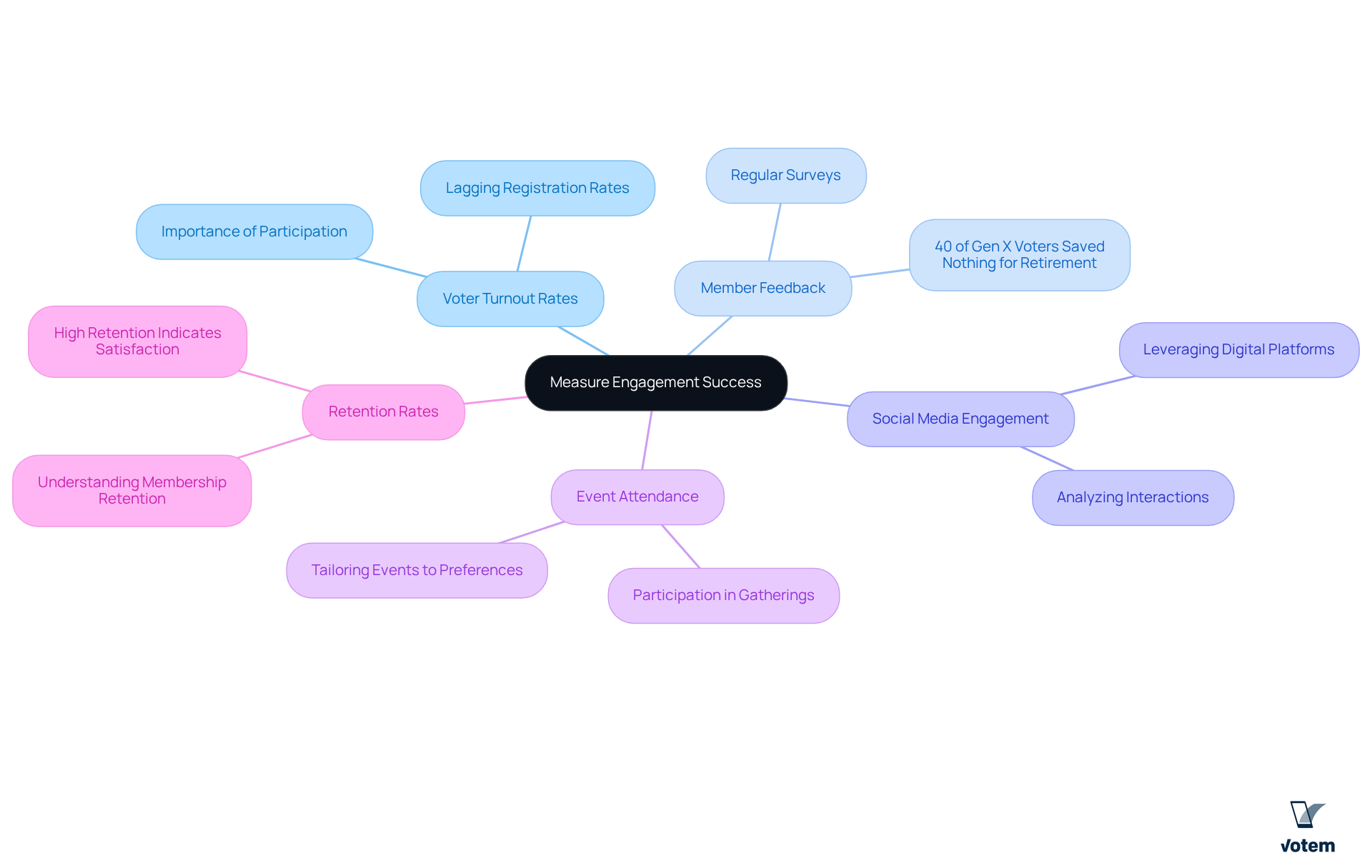
Adapt Strategies for Future Generations: Preparing for Millennials and Gen Z
To effectively engage constituents, labor leaders must adapt their strategies to resonate with Millennials and Generation Z. Consider the following key approaches:
-
Embrace Technology: As digital natives, younger generations demand seamless online interactions. Leveraging mobile apps and online platforms for communication and voting aligns with their preferences for convenience and accessibility. Votem’s innovative online voting solutions have proven to enhance accessibility for all qualified voters, including military personnel and individuals with disabilities. Notably, statistics reveal that 77% of Gen Z employees believe organized workplaces offer better benefits, underscoring the necessity for labor groups to harness technology to boost their appeal. Furthermore, 56% of Gen Z employees actively seek workplaces with labor organizations, highlighting the importance of adapting to their needs.
-
Focus on Social Issues: Millennials and Gen Z are particularly socially conscious. By emphasizing collective initiatives related to social justice, environmental sustainability, and workplace diversity, organizations can align with the values that resonate most with these demographics. Engaging in these discussions not only attracts younger individuals but also strengthens the organization’s commitment to broader social concerns.
-
Encourage Peer-to-Peer Engagement: Cultivating a culture of peer advocacy is essential. Younger participants can leverage social media to amplify organizational messages and engage their networks, fostering a grassroots movement that enhances visibility and support for collective initiatives. Case studies indicate that organizations promoting such engagement experience increased participation and loyalty among younger individuals.
-
Provide Educational Resources: Offering workshops and materials that inform younger individuals about their rights and the benefits of collective membership empowers them to actively participate in collective activities. This educational approach is crucial, as many younger workers prioritize personal growth and meaningful work, with 90% indicating that having a purpose-driven career is vital for their wellbeing.
-
Stay Flexible and Responsive: Unions must remain adaptable, ready to modify strategies based on feedback from younger participants. This responsiveness ensures that the organization stays relevant and addresses the evolving needs of its members. With trust in unions peaking among workers in their 30s and 40s, it is essential to bridge the generational gap by effectively addressing the concerns of both younger and older members.
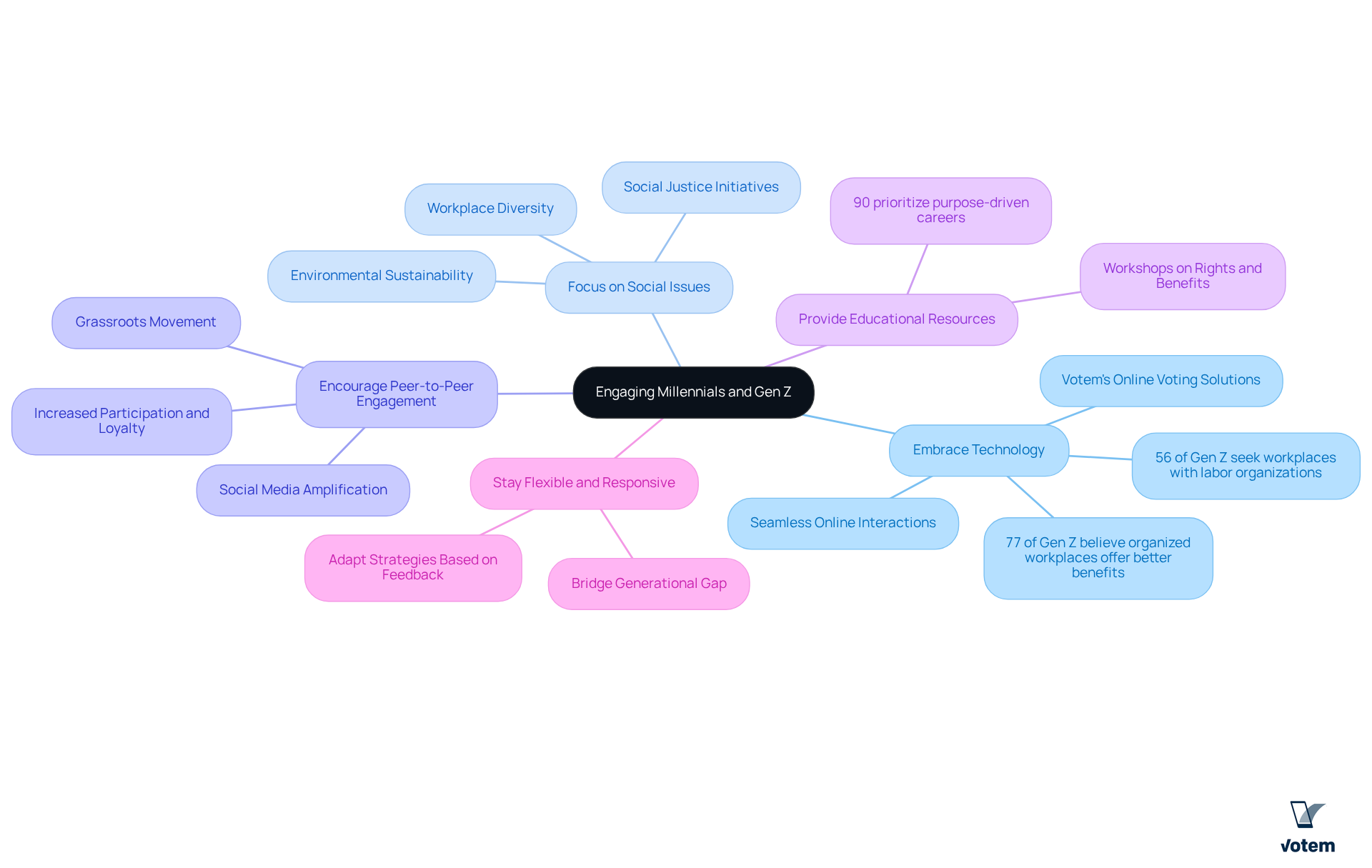
Conclusion
Understanding and effectively engaging Generation X voters is crucial for union leaders aiming to enhance participation and representation. By recognizing their unique characteristics—resourcefulness, a desire for authenticity, and economic pragmatism—leaders can tailor strategies that resonate with this demographic. The emphasis on practical solutions and clear communication is essential, fostering trust and encouraging active involvement in union activities and elections.
Key strategies include:
- Leveraging digital communication
- Fostering community engagement
- Highlighting the tangible benefits of union membership
Furthermore, implementing robust feedback mechanisms and utilizing data-driven insights can significantly improve outreach efforts. By addressing the economic concerns and values that drive Gen X voting behavior, union leaders can cultivate a deeper connection with this vital electorate.
As the landscape of political engagement continues to evolve, it is imperative for union leaders to adapt their strategies not only for Generation X but also for younger generations like Millennials and Gen Z. Embracing technology, focusing on social issues, and encouraging peer-to-peer engagement will create a more inclusive and effective environment for all members. Ultimately, the commitment to understanding and addressing the needs of Gen X voters will not only enhance union participation but also strengthen the collective voice in the broader political arena.
Frequently Asked Questions
What are the key characteristics of Generation X?
Generation X, born between 1965 and 1980, is known for their resourcefulness, independence, and strong sense of personal responsibility.
What is the economic influence of Generation X?
Generation X commands approximately 29% of the total annual household income in the U.S., highlighting their significant economic impact.
How do Generation X voters approach political issues?
Gen X voters value authenticity, often exhibit skepticism towards authority, prioritize work-life balance, and seek practical solutions over ideological extremes.
Why is it important for labor leaders to understand Generation X traits?
Understanding Gen X traits is crucial for effective engagement, as they respond well to openness, accountability, clear communication, and authentic representation of their concerns.
What role does Votem play in enhancing voter participation?
Votem provides innovative online voting solutions that improve accessibility and security, facilitating participation in elections for all eligible voters, including military personnel and individuals with disabilities.
What recent achievement did Votem accomplish regarding vote management?
Votem managed the receipt of 299,000 votes for the National Radio Hall of Fame, a notable increase from the previous year’s 126,000 votes, demonstrating the effectiveness of modern voting solutions.
What are Generation X’s political preferences?
Generation X tends to lean towards moderate or conservative positions, with a focus on economic concerns such as job security and healthcare.
How do economic issues influence Generation X’s voting behavior?
Economic issues, particularly job security and healthcare, significantly shape Gen X’s political engagement, as they prioritize policies that directly affect their livelihoods.
What percentage of Generation X earns a high income?
In 2023, 35% of Generation X individuals earn $150,000 or more, indicating their economic priorities.
How can labor leaders effectively engage Generation X voters?
Labor leaders should prioritize economic issues in their outreach efforts and articulate how collective initiatives can enhance job security and improve working conditions, aligning their messages with Gen X’s economic realities.
List of Sources
- Understand Generation X: Characteristics and Values
- 13 stunning stats on Gen X—the forgotten-yet-powerful generation | MONI Group (https://monigroup.com/article/13-stunning-stats-gen-x-forgotten-yet-powerful-generation)
- Poll: Gen X and Gen Z take different political paths (https://nbcnews.com/meet-the-press/first-read/poll-gen-x-gen-z-take-different-political-paths-rcna66264)
- Political Marketing: How to Reach Each Generation of Voters – Deep Sync (https://deepsync.com/political-marketing)
- Generation X: Years, stats, work, spending trends (https://the-future-of-commerce.com/2023/11/01/generation-x-definition-years-stats-work-spending-trends)
- Identify Political Preferences: What Drives Gen X Voting Behavior
- Poll: Gen X and Gen Z take different political paths (https://nbcnews.com/meet-the-press/first-read/poll-gen-x-gen-z-take-different-political-paths-rcna66264)
- Generation X – Ipsos Generations Report 2025 (https://ipsos-insight-llc.foleon.com/ipsos-thinks/ipsos-generations-report-2025/generation-x)
- How economic concerns are shaping the youth vote in 2024 | Brookings (https://brookings.edu/articles/how-economic-concerns-are-shaping-the-youth-vote-in-2024)
- Generation X’s Interest in Politics and Recent Exposure (https://medium.com/@lovefoods_54026/generation-xs-interest-in-politics-and-recent-exposure-d73dfa8aee53)
- Implement Engagement Strategies: Best Practices for Union Leaders
- How to Market to Generation X: Where Authenticity Meets Digital Efficiency (https://acornmktg.com/how-to-market-to-generation-x)
- Digital adapters: How Gen X uses social media and why it matters to marketers (https://sproutsocial.com/insights/gen-x-social-media)
- Gen Z, Millennials and Gen X outvoted older generations in 2018 midterms (https://pewresearch.org/short-reads/2019/05/29/gen-z-millennials-and-gen-x-outvoted-older-generations-in-2018-midterms)
- How to Increase Union Membership: 12 Proven Strategies for Growth (https://union.dev/blog/articleid/51/how-to-increase-union-membership)
- 7 Strategies to Engage Union Voters Effectively | Online Voting with Votem® (https://votem.com/7-strategies-to-engage-union-voters-effectively)
- Measure Engagement Success: Evaluating Strategies and Outcomes
- Viewpoint: How to Engage and Retain Generation X (https://shrm.org/topics-tools/news/employee-relations/viewpoint-how-to-engage-retain-generation-x)
- Voter Registration Rates by Generation – Berkeley Initiative for Young Americans (https://youngamericans.berkeley.edu/2024/04/voter-registration-rates-by-generation)
- The Forgotten Generation: Gen X As Catalysts For Future Growth (https://forbes.com/sites/vibhasratanjee/2025/02/01/the-generation-you-forgotgen-x-as-catalysts-for-future-growth)
- Engaging Generation X Employees at Work | Hire Velocity (https://blogs.hirevelocity.com/5-ways-to-engage-and-retain-your-generation-x-workforce)
- State of the U.S. Unions 2025 (https://ericdirnbach.medium.com/state-of-the-u-s-unions-2025-34ad1e2974da)
- Adapt Strategies for Future Generations: Preparing for Millennials and Gen Z
- Gen Z’s Vision for Unions: Address AI, Hybrid Work, and Work-Life Balance, According to LaborStrong Survey (https://businesswire.com/news/home/20250312521537/en/Gen-Zs-Vision-for-Unions-Address-AI-Hybrid-Work-and-Work-Life-Balance-According-to-LaborStrong-Survey)
- Gen Z Is Changing the Union Game—But the Rules Haven’t Kept Up (https://news.lrionline.com/gen-z-is-changing-the-union-game-but-the-rules-havent-kept-up)
- Gen Z Drives Union Support Amid AI Layoffs And Workplace Changes (https://nationalenquirer.com/gen-z-drives-union-support-amid-ai-layoffs-and-workplace-changes)
- Gen Z Workers Look to Unions to Champion the Future of Work | LaborStrong (https://laborstrong.live/blog/gen-z-workers-look-to-unions-to-champion-the-future-of-work)
- Changing priorities: what matters to Gen Zs and millennials in the workplace? (https://dentons.com/en/insights/articles/2025/june/26/changing-priorities-what-matters-to-gen-zs-and-millennials-in-the-workplace)

